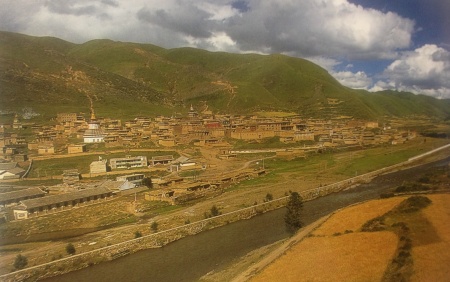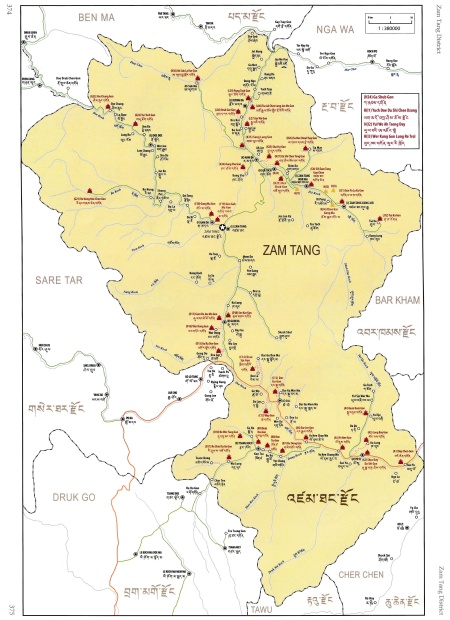Dzamtang

Dzamtang (Tib. འཛམ་ཐང་, Wyl. ‘dzam thang), aka Dzamthang, or Zamthang, is a county division of Ngawa Autonomous Prefecture, but culturally belongs to Golok.[1].
Located in the southern part of Golok, in the Ngawa Qiang Autonomous Prefecture in north China's Sichuan Province, People's Republic of China. It has an area of 6,637 square kilometres and has 44,679 inhabitants. Its main town is the greater municipality of Dzamkog. In a remarkable way Dzamtang demonstrates the transition from the secluded gorges of Gyarong and Kham to the vaster grasslands of Amdo. It is no wonder that it was an important thoroughfare and pivot for pilgrims, religious teachers, traders and caravans travelling between central Amdo, the Golok country, Gyarong and the Kandze region of Kham. Around the turn of the 19th century to the 20th century, Dzamtang has lost its openness, presumably due to the aggressive missionary behaviour of the Gelukpas of Labrang. Historically, the monasteries and the secular rulers of Dzamtang were politically independent from both the Tibetan Lhasa and neighbouring Chinese provincial governments.[2]
Dzamtang is the stronghold of the Jonang tradition, and has a strong presence of the Nyingma and Kagyü schools. The Gelukpa seems to be entirely absent in Dzamthang. [3]
Geography
Position
Dzamtang county occupies the Do Chu (Tib. མདོ་ཆུ་, Wyl. mdo chu) valley in the west and south, from the grasslands and gorges of its mid-reaches through its confluence with the Dzi Chu (Tib. རྫི་ཆུ་, Wyl. rdzi chu) river and thus the Dzi Chu valley in the east. At the Dzi Chu valley northeast, the forested gorges with their stone and wooded houses suddenly blend into open grasslands inhabited by yak herding nomads.[4]
The county shares borders with Padma Dzong (Tib. པདྨ་, Wyl. pad+ma) and [Ngawa]] (Tib. རྔ་བ་ , Wyl. rnga ba) district in the north, Barkam (Tib. འབར་ཁམས་, Wyl. ‘bar khams) in the east, Chuchen (Tib. ཆུ་ཆེན་, Wyl. chu chen), Ta’u (Tib. རྟའུ་, Wyl. rta’u) and Drakgo (Tib. བྲག་མགོ་, Wyl. brag mgo) in the south and Serta (Tib. གསེར་ཐར་, Wyl. gser thar) in the west. The county capital is located at Dzamtang, 152 km from Gongentang, 213 km from Barkham, and 155 from Drango. Dzamthang is inaccessible to western travellers.[5]
Rivers

The two main rivers of Dzamtang county are the Do Chu (Tib. མདོ་ཆུ་, Wyl. mdo chu) and Dzi Chu (Tib. རྫི་ཆུ་, Wyl. rdzi chu) rivers. The Do Chu is in the western part of the county and enters north from Pema county and flows down south, joining the Ser Chu (Tib. གསེར་ཆུ་, Wyl. gser chu) coming from Serta county westwards and then turning east to exit Dzamtang towards Chuchen (Tib. ཆུ་ཆེན་, Wyl. chu chen) county. The Dzi Chu has its spring in the eastern-middle part of Dzamtang and flows north to exit Dzamtang at its border to Pema county, joining the Mar Chu (Tib. དམར་ཆུ་, Wyl. dmar chu) river, taking the stream further eastwards. [6]
Mountains
- Xiangla Dongji mountain area is about 30 square kilometres large, and located some 29 kilometres from Dzamtang county. This is a mountain that has never been touched by anyone because it is one of sacred mountains of Gesar, being regarded as inviolable. “Shangra Dongji” sacred mountains is shaped like a “Zhong (众)” symbol of Chinese, it is thought to be incarnation of Vajrapani, and being surrounded by 88 snow-capped mountains, which are servants of Holy Mountain according to legend.
- Haizi Mountain area is located at junction of three counties of Dzamtang, Aba and Barkham. It is about 80 kilometres from county seat. Haizi Mountain means “mountain with Haizi (Lake)”. There are about 35 lakes. Haizishan is 4,760 meters above sea level, its main peak is called “Zun-ma” means “Queen”; It is said to be “Queen” of Anyé Machen Pomra in Qinghai, whom wearing a silver cloak, riding a white horse, holding a wishful treasure, protecting a living creature.[7]
Cities
The main cities of Dzamtang county are the following:
- Dzongda (Tib. རྫོང་མདའ་, Wyl. rdzong mda’, Ch. Dzongda 茸木达乡)[8]
- Dodö (Tib. རྡོ་སྡོད་, Wyl. rdo sdod, Ch. Shangduke 上杜柯乡) [9]
- Drukje
- Dzamtang (Tib. འཛམ་ཐང་, Wyl. ‘dzam thang, Ch. Zamthang-koān 壤塘), aka Dzamthang, Dzamkhog , the county town, is drab and uninspiring with a high Chinese population.[10]
- Dzamtang Barma (Tib. འཛམ་ཐང་བར་མ་, Wyl. ‘dzam thang bar ma, Ch. Dzamtang 中壤塘乡) [11]
- Dzamtang Gungya (Tib. འཛམ་ཐང་གུང་རྒྱ་, Wyl. ‘dzam thang gung rgya, Ch. Xiemuda 协木达)[12]
- Dzongda
- Getok (Tib. གད་ཐོག་, Wyl. gad thog, Ch. Gaduo/Katok 尕多乡)[13]
- Gumda (Tib. རྒུ་མདའ་, Wyl. rgu mda’, Ch. Gangma 冈玛)[14]
- Kamda (Tib. རྐ་མདའ་, Wyl. rka mda’, Ch. Gangmuda 岗木达乡)[15]
- Köntsa (Tib. ཁོན་ཙ་, Wyl. khon tsa, Ch. ?)[16]
- Namda (Tib. ན་མདའ་, Wyl. na mda’, Ch. Namda 南木达乡)[17]
- Posu (Tib. ཕོ་སུ་, Wyl. pho su, Ch. Puxi 蒲西乡)[18]
- Sili (Tib. སི་ལི་, Wyl. si li, Ch. Shili 石里乡)[19]
- To-de
- Tsanghok
- Yutok
History
‘Dzam’ in the name ‘Dzamtang’ is rumoured to have derived from a village located in the region that was located on a hill in the shape of the wealth god Dzambhala holding a banner. Thang refers to the plain (thang) in front of that village [20] Most of the Tibetan people in Dzamtang are Gyalrong people (Tibetan: རྒྱལ་རོང་). They mainly speak Amdo Tibetan dialect. The folk costumes in Dzamtang are mainly made from used sheepskin and pupu (wool material woven with wool). The Dzamtang robe is long, with a broad front and border. In some Tibetan festivals, people in Dzamtang will wear a felt hat, a silk ribbon around the waist, a waist knife. [21]
With numerous monasteries of the Kagyü in the Do Chu valley in the west, and predominantly Nyingma presence in Dzamtang, the most remarkable occurrence is without doubt that of the Jonang school in the Dzikok valley. The major monastic seat (Wyl. gdan sa) of the Jonang tradition is Tsangwa that along with Choje Monastery became a sanctuary for the Jonangpa in Amdo. Today, Tsangwa is the central monastic complex of the Jonang and is associated with Jonang affiliate monasteries (dgon lags) throughout Eastern Tibet. Since the suppression of the Jonang as a whole in Central Tibet was strongly enforced by the Ganden Podrang government, it shows that they had no rule over Dzamtang and Golok as a whole. Tsangwa Monastery was established by Lodro Namgyal, one of Taranatha's heart disciples. In 1658, the year that Taranatha's seat Takten Damcho Ling was forcefully converted to Gelukpa in Central Tibet, Lodro Namgyal bestowed the full Kalachakra empowerment at this site during its inauguration ceremony. Also, the Collected works of Taranatha survived in the print edition of Dzamthang.
Dharma
Dharma Lineages
The main tradition lineages practised are those related to:
Main Dharma Places
- Chöje Monastery of Dzamtang (Tib. འཛམ་ཐང་དགོན་ཆེན་གྱི་སྒར་ཁག་གསུམ་ལས་ཆོས་རྗེ་གྲྭ་ཚང་, Wyl. ‘dzam thang dgon chen gyi sgar khag gsum las chos rje grwa tshang) has 500 Jonang monks. It is in Dzamthang Barma and forms part of the triplet of major Jonang monasteries being the oldest of the three, established in 1425 by Rinchen Pel.
- Do Yutok (Tib. མདོ་གཡུ་ཐོག་, Wyl. g.yu thog) Do Yutok Gon close to Yutok is a Nyingma monastery with about 500 monks.
- Dzidrup Barshi Chöde (Tib. མཛི་སྒྲུབ་བར་ཤིས་ཆོས་སྡེ་, Wyl. mdzi sgrub bar shis chos sde) has 100 Jonang monks. In Getok.
- Gabma aka Tenten (Tib. གབ་མ་/སྟན་རྟན་, Wyl. gab ma /stan rtan) has 105 Kagyü monks. In Kamda.
- Gongma aka Tashi Chöling (Tib. གོང་མ་/་བཀྲ་ཤིས་ཆོས་གླིང་, Wyl. gong ma / bkra shis chos gling) has 100 Nyingma monks. In Kamda.
- Khangshog, Leb and Dongbo Dargye Ling (Tib. ཁང་ཤོག/ལེབ/་དོང་བོ་དར་རྒྱས་གླིང་, Wyl. khang shog /leb / dong bo dar rgyas gling) has 150 Nyingma monks in Namda.
- Pangtok and Tubten Shedrup Norbu’i Ling (Tib. སྤང་ཐོག་/ཐུབ་སྟན་བཤད་སྒྲུབ་ནོར་བུའི་གླིང་, Wyl. spang thog / thub stan bshad sgrub nor bu’i gling) has 105 Nyingma monks in Dzongda.
- Sanglung and Tubten Pelgye Ling (Tib. གསང་ལུང/་ཐུབ་སྟན་འཕེལ་རྒྱས་གླིང, Wyl. gsang lung / thub stan ‘phel rgyas gling) has 300 Nyingma monks in Namda.
- Semar Peltse Tashi Chökhor Ling (Tib. སད་མར་དཔལ་རྩེ་བཀྲ་ཤིས་ཆོས་འཁོར་གླིང་, Wyl. sad mar dpal rtse bkra shis chos ‘khor gling) has 110 Jonang monks. In Getok.
- Sertang Dechen Ling (Tib. གསེར་ཐང་བེ་ཆེན་གླིང་, Wyl. gser thang be chen gling) has 7 Nyingma monks in Tsangkog. [22]
- Shichung aka Tubten Shedrup Ling (Tib. ཤིས་ཆུང་/ཐུབ་བསྟན་བཤད་སྒྲུབ་གླིང་, Wyl. shis chung /thub bstan bshad sgrub gling) has 100 Nyingma monks and 15n nuns. In Dotö.
- Shukjung Monastery (Tib. ཤུགས་འབྱུང་དགོན་པ་, Wyl. shugs 'byung dgon pa) - in the Do Valley around Yutok is located about 15 to 20 miles from Dodrupchen Monastery. It belongs to the Northern Treasures tradition, and was the residence of Tulku Tsultrim Zangpo, aka Tulku Tsullo. It has about 500 monks.
- Tashi Chöthang Nobu’i Ling (Tib. བཀྲ་ཤིས་ཆོས་ཐང་ནོར་བུའི་གླིང་, Wyl. bkra shis chos thang nor bu’i gling) has 100 Jonang monks. In Getok.
- Tsangwa Monastery of Dzamthang (Tib. འཛམ་ཐང་དགོན་ཆེན་གྱི་སྒར་ཁག་གསུམ་ལས་གཙང་བ་གྲྭ་ཚང་, Wyl. ‘dzam thang dgon chen gyi sgar khag gsum las gtsang ba grwa tshang) is divided into Tsangchung and Tsangchen Monasteries and with 2000 Jonang monks in Dzamthang Barma is Jonang monastery that was founded in 1717 by Lodro Namgyel. It is one of three monasteries, the other two being Choje and Tsechu, that comprise the Dzamtang monastic complex and thus the central institution of the Jonang school. Jigme Dorje, the head of the Jonang enjoys great fame in China which contributes to fame and wealth of the triplet of Jonang monasteries. Recently, the construction of a multi-storey 3-D Kalachakra mandala was undertaken at the site.[23]
- Yutok Namgyal(Tib. གཡུ་ཐོག་རྣམ་རྒྱལ་, Wyl. g.yu thog rnam rgyal) 550 Kagyü monks. In Dotö. Yutok Monastery is a Karma Kagyu institution in Dzamtang, Amdo, that was founded by Situ Paṇchen Chokyi Jungne.
- 'Tsechu Monastery of Dzamthang (Tib. འཛམ་ཐང་དགོན་ཆེན་གྱི་སྒར་ཁག་གསུམ་ལས་ཚེ་བཅུ་གྲྭ་ཚང་, Wyl. ‘dzam thang dgon chen gyi sgar khag gsum las tshe bcu grwa tshang) has 100 Jonang monks. It is in Dzamthang Barma and forms part of the triplet of major Jonang monasteries.
Main Teachers
- Bamda Gelek (Tib. འབའ་མདའ་དགེ་ལེགས་, Wyl. ‘ba’ mda’ dge legs) (1844-1904), a Rime master from Dzamtang who was principally trained in the Kagyü and Nyingma traditions and head of Yutok monastery. [24]
- Jigme Dorje (Tib. འཇིགས་མེད་རྡོ་རྗེ་, Wyl. ‘jigs med rdo rje), the present holder of the Jonang tradition and head of Tsangwa monastery. He is one of the most renowned teachers at the Tibetan-Buddhist Academy of China’s capital, Beijing.
- Rinchen Pel (Tib. རིན་ཆེན་དཔལ་, Wyl. rin chen pdal །, 1350-1435), an early Jonang lama and founder of Chöje monastery.
- Tulku Tsullo aka Tsultrim Zangpo (Tib. སྤྲུལ་སྐུ་ཚུལ་བློ་ཚུལ་ཁྲིམས་བཟང་པོ་, Wyl. sprul sku tshul blo tshul khrims bzang po, 1884-1957), holder of the Northern Treasures.
Notes
- ↑ Emeric Yeshe Dorje, The History of the Düdjom Tersar Lineage, Volume 1: “Golok”, forthcoming.
- ↑ Andreas Gruschke, The Cultural Monuments of Tibet’s Outer Provinces, Amdo, Volume 2. The Gansu and Suchuan Parts of Amdo, White Lotus, 2001, p.67
- ↑ Emeric Yeshe Dorje, The History of the Düdjom Tersar Lineage, Volume 1: “Golok”, forthcoming.
- ↑ Gyurmé Dorjé, Tibet, Footprint, 3rd edition, p.645.
- ↑ Stewart Smith, The Monasteries of Amdo, Volume 1: East and South Amdo, 2017, Stewart Smith, p.129.
- ↑ Emeric Yeshe Dorje, The History of the Düdjom Tersar Lineage, Volume 1: “Golok”, forthcoming.
- ↑ https://tibetantrekking.com/kham-destinations-guide/zamthang-county/
- ↑ https://mapcarta.com/N3328681023
- ↑ https://mapcarta.com/N4169055362
- ↑ https://mapcarta.com/25439892
- ↑ https://mapcarta.com/N3329529396
- ↑ https://mapcarta.com/26315544
- ↑ https://mapcarta.com/N3328681019
- ↑ https://mapcarta.com/26315522
- ↑ https://mapcarta.com/N3328986787
- ↑ https://mapcarta.com/N4168573661
- ↑ https://mapcarta.com/15946088
- ↑ https://mapcarta.com/N3330051075
- ↑ https://mapcarta.com/N3330229918
- ↑ https://en.wikipedia.org/wiki/Zamthang_County
- ↑ https://en.wikipedia.org/wiki/Zamthang_County
- ↑ Stewart Smith, The Monasteries of Amdo, Volume 1: East and South Amdo, 2017, Stewart Smith, p.116-128.
- ↑ https://treasuryoflives.org/institution/Tsangwa-Monastery
- ↑ https://treasuryoflives.org/biographies/view/Bamda-Gelek/7272